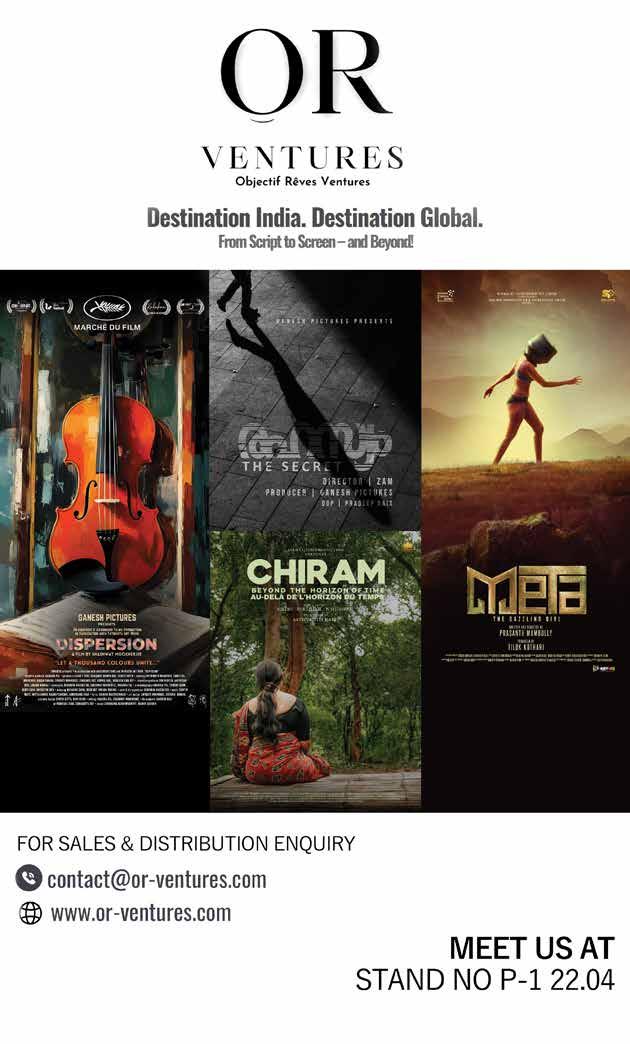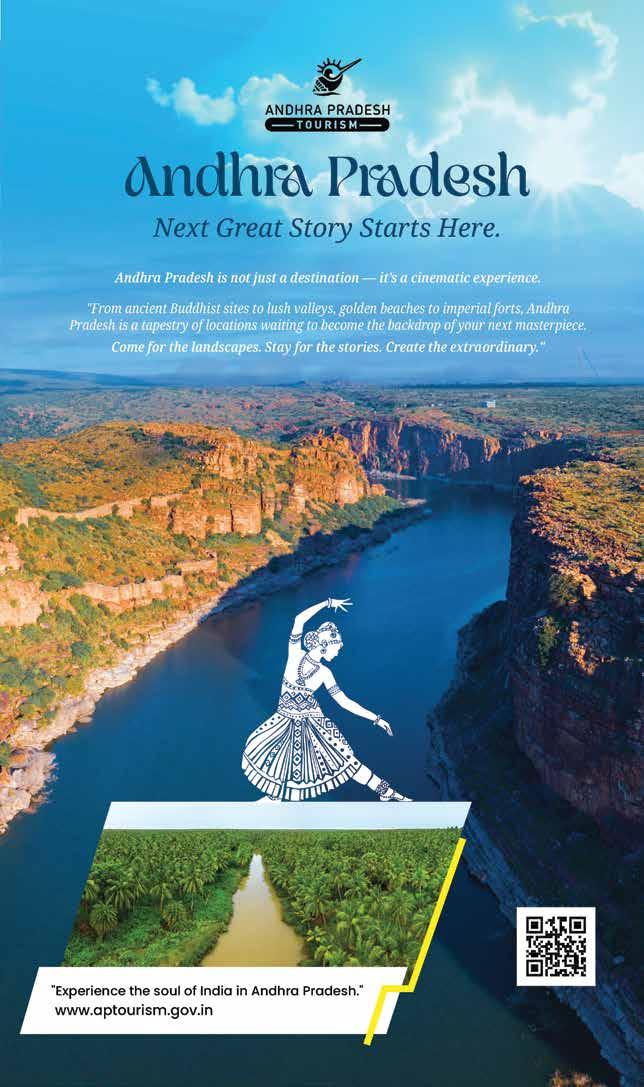
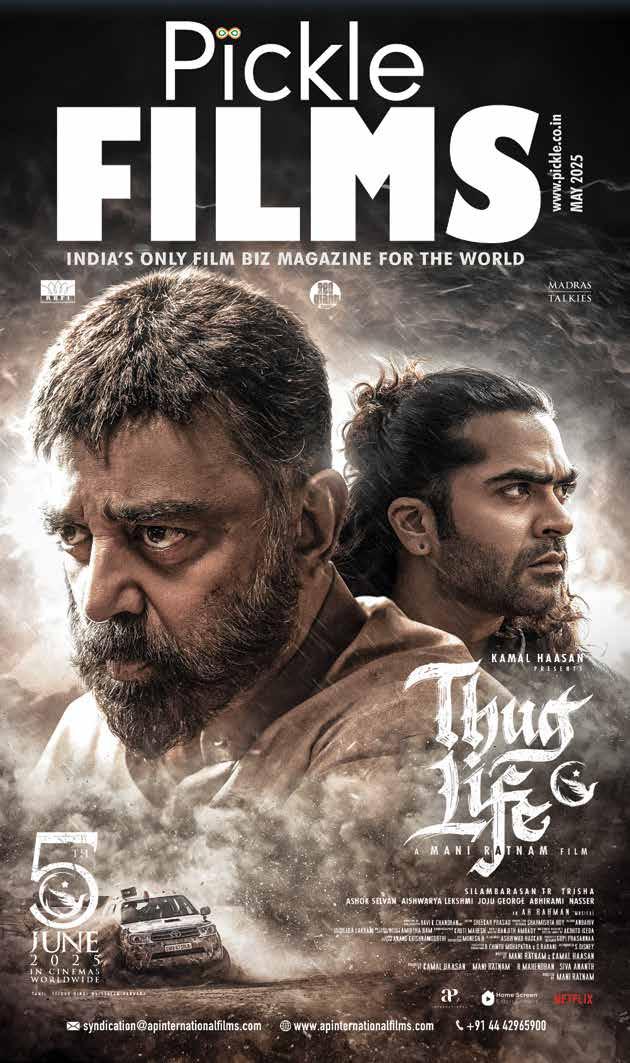
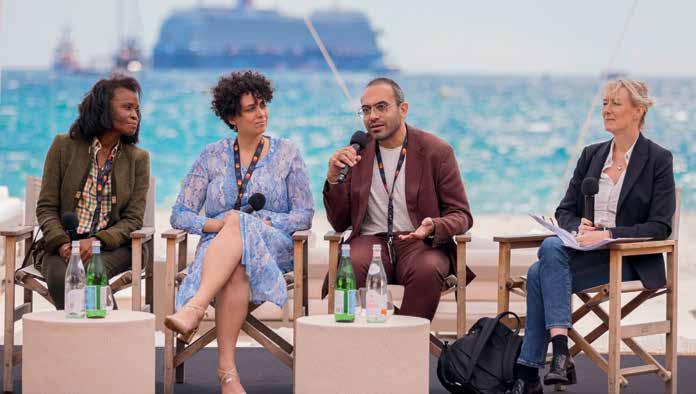





















ickle proudly presents its Cannes issue, celebrating India’s remarkable presence at the 78th Cannes Film Festival, held from May 13 to 24, 2025. As the world converges on the French Riviera to honour global cinema, India steps forward with renewed confidence, creativity, and a clear vision to engage with the international filmmaking community.
This year’s Indian lineup at Cannes is both exciting and emblematic of our growing stature. Neeraj Ghaywan’s Homebound is competing in the Un Certain Regard section, while A Doll Made Up of Clay, a collaborative student film from SRFTI, features in La Cinef, underscoring the emergence of powerful new voices from India’s academic institutions. Satyajit Ray’s Aranyer Din Ratri will also be shown in the Cannes Classic Section. These selections affirm India’s evolving narrative sensibility and its resonance on global platforms.
It is also a great moment for India as filmmaker Payal Kapadia is returning to the Cannes Film Festival 2025 as part of its prestigious jury after her Grand Prix win at the festival in 2024 for her debut feature film All We Imagine As Light.


India is fast becoming a hub for filmmaking, not just for its diverse landscapes and rich cultural backdrops, but for its forward-thinking policies, infrastructure, and talent pool. With incentives worth USD 3.6 million, a streamlined single-window clearance system, and



Pickle Volume XVIII 1




just announced Indian Institute of Creative Industries, India is offering unmatched value for global producers, studios, and storytellers.

The successful hosting of the World Audio Visual and Entertainment Summit (WAVES) in Mumbai earlier this month added a powerful new dimension to India’s creative ecosystem. Over 100 countries participated in the summit to amplify India’s creative voice on the global stage.
Cannes continues to hold immense strategic importance for India. It serves as a gateway to the global entertainment market. It is here that India’s rich regional diversity and contemporary narratives can find new audiences and cross-border appreciation.
The Bharat Pavilion at Cannes plays a pivotal role in facilitating conversations with the world cinema. It is a vibrant space for networking, co-production discussions, and showcasing India’s film heritage and future ambitions. The Confederation of Indian Industry is in the Marketplace at Marche near the cafeteria.

As we celebrate India’s cinematic journey, we invite you to engage with our content, share your thoughts, and explore collaboration opportunities within the dynamic Indian film industry. Your feedback is invaluable as we continue to bring you the latest insights, trends, and voices from the global entertainment


Let’s create, connect, and celebrate cinema—



nat@pickle.co.in, www.pickle.co.in


Published by Pickle Media Private Limited
Email: natvid@gmail.com l Chennai No.2, Habib Complex Dr Durgabhai Deshmukh Road RA Puram CHENNAI 600 028

For advertising: natvid@gmail.com / pickle@pickle.co.in
Pickle Business Guide 2025 Copyright 2025 by
Pickle Media Pvt Ltd. All Rights Reserved.
Senior Editor : Vivek Ratnakar
Editorial Coordinators : Maitreyi Vidyasagar, Shruti Sundaranand
Design: Jose J Reegan, James, D Sharma, S Lakshmanan
Photo Editor : K K Laskar

Admin & Operations : B Rajalakshmi Email: natvid@gmail.com
Pickle is an ad supported business guide tracking the filmed entertainment business in India.






















For more details
























































































Kokob Gebrehaweria Tesfay

Country: India | Duration: 24
Cast: Ibrahim Ahmed, Geetha Doshi
Music: Himangshu Saikia
Cinematography: Vinod Kumar
Editing: Mahmud Abu Naser
Production: Satyajit Ray Film & Television Institute
www.srfti.ac.in | Prathyush Kotha | pckotha@ gmail.com
After selling his father’s land to chase a football career in India, a Nigerian footballer suffers a devastating injury that ends his dreams. Lost and desperate, he seeks escape through the healing power of his ancestral rituals.
| By
Country: India | Duration: 119
Cast: Ishaan Khatter, Vishal Jethwa, Janhvi Kapoor
Cinematography: Pratik Shah
Music: Naren Chandavarkar
Screen Play: Neeraj Ghaywan
Producer: Dharma Productions
Distribution: Ad Vitam arthur@advitamdistribution.com

Two childhood friends from a small North Indian village chase a police job that promises them the dignity they’ve long been denied. But as they inch closer to their dream, mounting desperation threatens the bond that holds them together.
Aranyer Din Ratri (Days and Nights in the Forest) | By Satyajit Ray

Country: India | Duration: 116
CAST: Soumitra Chatterjee, Subhendu Chatterjee, Samit Bhanja Sharmila
Tagore, Aparna Sen
Producer: Priya Films pndutta12@gmail.com
In a work that confirms Satyajit Ray’s place amongst the masters of world cinema, Days and Nights in the Forest tells the tale of four brash young men from the city who set out on a lark to the forests of Jharkhand to escape their mundane urban lives, not realizing that it will challenge their views on life and love and blunt their confidence.
Aditya SINHA
Anusha IYER
Eram
Navjeet KAUR
Rohit PATHAK
CONTENT & ART Deepti CHAWLA Producer/ Executive Producer
INNOVATIVE FILM ACADEMY Saravana PRASAD
50 INSTITUT FRANÇAIS (INDE) Mathieu BEJOT
pathrohit@gmail.com
Attaché audiovisuel
JAI VIRATRA ENTERTAINMENT LIMITED Manoj NANDWANA Sales manoj@jaiviratra.com
Irina ASADULINA
Producer Mark VERNY GORELKINE TRANSLATOR
52 JOYCE CREATIVE STUDIOS Joyce AHUJA CEO and Animation Director
KALPANA CHITRA Kalpana KONERU pichasu
54 KARNATAKA CHALANACHITRA ACADEMY
55 KARUVACHY FILMS
Sadhu Kokila DORESWAMY
Leena MANIMEKALAI RAGHUPATHY
56 KAYAANTARAN STUDIOS LLP Tanmaya SHEKHAR
57 LALL ENTERTAINMENT Bhuvan LALL
CHAIRMAN, KARNATAKA CHALANACHITRA ACADEMY
Film Director; Producer
Writer-Director-Producer
Writer - Director - Producer lallentertainment@gmail.com
58 LASUTRA PICTURES Sunitha RAM Co-Founder & Executive Producer/Producer sunitha.rams@gmail.com 59 MACGUFFIN PICTURES Honey Jewan Jyoti TREHAN
MAHARASHTRA FILM, STAGE & CULTURAL DEVELOPMENT CORPORATION LTD
61 MAK WORLD FILMS
62 MEDIASMITHS IMAGE CONSULTANTS PVT LTD
MANOJ Kadam Coordinator 24framesentertainment@gmail.com
Vikas SHANKAR KHARAGE
Swati MHASE
Deepak KUMAR
Geeta DESHPANDE
Jayant SOMALKAR
Makarand Vinayak DESHPANDE
Nivedita Sudhir POHANKAR
Amit ROY
Sanjay RAM
Malvika SANT
Principal Secretary
Managing Director
Producer deepak@sfsllp.co.in
Cheif Administrative Officer
Writer - Director - Producer jayant.somalkar@gmail.com
Actor, Director, Producer
Writer - Director
Cinematography
Co-Founder
Producer
METRO PICTURES Amit JUMANI
MUGAFI PRIVATE LIMITED Tansha BATRA CMO Vipul AGRAWAL Founder & CEO
amit@metropictures.in
65 MULTIVISION MULTIMEDIA INDIA PVT LTD Sunil UDHANI Country Head sunil.udhani@mvpworld.com
66 NATIONAL FILM DEVELOPMENT CORPORATION / NFDC INDIA (LTD)
Shruti RAJKUMAR
Nachiket SHIROLKAR
Pankaj SAXENA
67 NH STUDIOZ
Head Film Facilitation Office shruti.rajkumar@investindia.org.in
Consultant, International Promotions and Special P nachiket@nfdcindia.com
Artistic Director, IFFI
Vineeta Shyam MISHRA Head - Programming, Film Bazaar vineeta@nfdcindia.com
Shreyans HIRAWAT Director sh@nhstudioz.tv
Ashlin FRANKLIN
Sales Executive Usha MAGERI Buisness Development Executive
68 NXT DIGITAL LTD Prakash P. HINDUJA
69 PAPER PLANES PICTURES PVT LTD Lisa DCOSTA
Managing Director
Executive Producer & Founder lisa@paperplanes.pictures
70 PICKLE MEDIA PVT LTD Natarajan VIDYASAGAR Editor nvidyasagar@gmail.com
71 PICTUREWORKS Avinaash JUMANI
Film Acquisitions and Sales avinaash@pictureworksindia.com Suvidhi RUIA
72 POLKA DOTS LIGHTBOX Smriti KIRAN
International Acquisitions
Founder and Director
73 PRASAD CORPORATION PVT LTD Petr RYZHENKOV Regional Sales Director- EU
74 PVR INOX PICTURES LTD/PVR INOX LTD.
Sanjeev KUMAR Joint Managing Director sanjeev@pvrcinemas.com
Kamal GIANCHANDANI
SHARMA COO
75 R.D. FILMS Ram GOPALAKRISHNAN MANI Proprietor 76 RISING NOVA Dilip ADVANI
77 RRE STUDIOS PRIVATE LIMITED Rajshree AGARWAL
78 RUCHA PATHAK (INDEPENDENT) Rucha PATHAK
79 RUCHI SHARMA (INDEPENDENT) Ruchi SHARMA
80 SEYON-DI Kathiravan MURUGAN
rajshree@rrestudios.com
roo.filmsandcreative@gmail.com
Director kathir@seyon-di.com
murtuza@contentino.in 82 SHREYAS SRINIVAS (INDEPENDENT) Shreyas SRINIVAS
Incentives, IP safety, and cinematic scale—India’s the scene-stealer for international producers looking to go big, bold, and global.
From groundbreaking advancements in digital innovation and talent development to its deep well of stories and proactive policy environment, India is emerging as one of the most exciting destinations for global filmmakers. With its audiovisual and media & entertainment (M&E) industry on track to become a $100 billion powerhouse by 2030, India is no longer just a market — it’s a creative movement. Here are ten compelling reasons why working with India through the lens of filmmaking makes strategic and creative sense.
India’s M&E sector is experiencing exponential growth, driven by blockbusters like RRR, Kalki 2898 AD, and Jawan, and a thriving digital content economy. The expansion of OTT platforms and rising global interest in Indian narratives has placed India firmly on the international filmmaking map. Whether it’s cinema, animation, gaming or VFX, India offers scale, speed, and storytelling at a worldclass level.
India is actively inviting the world to shoot, co-create, and co-produce. Through the “Film in India” scheme, the government now offers up to 40% rebate on qualifying production expenditures, with an enhanced cap of INR 300 million (approximately USD 3.6 million). Additional incentives are available for productions showcasing Indian culture or employing Indian talent, making the value proposition hard to beat.
India’s biggest asset is its people — a young, skilled, and tech-savvy workforce. From award-winning directors and screenwriters to world-class editors, animators, and VFX artists, India is a hotbed of creative talent. Institutions like the National Centre of Excellence (NCoE) are further honing skills to meet global standards, ensuring highquality outputs at competitive costs.
India is a storyteller’s paradise. With 22 official languages and dozens of filmmaking cultures, the country provides a kaleidoscope of narratives — historical epics, mythological sagas, intimate family dramas, and high-concept sci-fi. Stories rooted in India’s diversity have found global resonance, as seen in the international acclaim for films like Lagaan, The Lunchbox, and RRR.
India has signed audio-visual co-production agreements with over 15 countries, including France, the UK, Canada, Australia, and Italy. These pacts provide producers with access to government incentives from both countries, reduce financial risks, and facilitate smoother regulatory approvals. It also enables seamless cultural and creative exchange, making collaboration easier and more rewarding.
India’s Ministry of Information & Broadcasting is proactively championing the audiovisual sector. From the establishment of the NCoE to the rollout of the draft AVGC Policy, the Indian government is creating a nurturing environment for global filmmakers. Legal reforms such as amendments to the Copyright Act and Cinematograph Act enhance IP protection and ease of doing business.
India offers state-of-the-art production infrastructure — sound stages, postproduction suites, animation hubs, and VFX labs — at a fraction of the cost in Western markets. Cities like Mumbai, Hyderabad, and Chennai are equipped with internationally certified facilities, while scenic states like Rajasthan, Kerala, and Himachal Pradesh provide breathtaking backdrops, supported by local film commissions.
India: The World’s Next AVGC Hub
India’s AVGC (Animation, Visual Effects, Gaming, and Comics) sector is among the fastest growing in the world. The government has announced the creation of a National AVGC Mission to boost exports, enable training, and position India as a global leader in digital content creation. Studios in India have already contributed to global hits like The Lion King and Avengers: Endgame.
With over 1.4 billion people and one of the youngest populations globally, India offers an audience hungry for global content as well as platforms looking for international collaborations. International productions that partner with India not only access talent and locations — they also tap into a booming consumer market increasingly connected via OTT and mobile-first platforms.
India’s global positioning — as a democratic, culturally rich, and increasingly techforward nation — makes it a trusted creative collaborator. India’s soft power is growing, not only through cinema but also through its influence on global storytelling trends, digital culture, and diaspora connections. This makes working with India not just strategically viable, but also socially resonant.
India is no longer on the sidelines — it is at the center of the global content conversation. With its combination of talent, incentives, policy support, stories, and infrastructure, India is redefining what it means to be a filmmaking partner. Whether you are a global studio, indie filmmaker, streaming giant, or animation house, India is ready to collaborate, co-create, and co-produce. The world is watching India’s creative surge. The real question is — will you be part of it?
India has always had a rich storytelling tradition, each peppered with nuances of our diverse culture. From mythology to history, we are steeped in tradition.
By Shruti Rajkumar

Shruti Rajkumar, Vice President and Head of the Film Facilitation Office at Invest India
Indian cinema has over the past century taken on the mantle of telling these stories and has today become the largest film industry in the world. While many remarkable films have been produced over the years, there have only been a few sporadic international successes. From Chello Show which made it to the Oscars, All We Imagine As Light which won accolades at Cannes and Girls Will Be Girls which made India proud at Sundance.
While there has been a growing interest in films set in India and these films have exceptional performances both on and off screen, Government support plays a huge role in supporting filmmakers and providing them with the push needed to take risks.
Over the past decade, The Government of India has implemented various schemes to facilitate, promote and incentivise film production in India. The Film Facilitation Office now renamed India Cine Hub (ICH) for instance was set up in 2015 as a single window mechanism that aims to ease the process of filming in India. Over the years, more than 300 foreign films including official coproductions have been facilitated – in line with Government’s promise to promote the Ease of Doing Business in all sectors.
Another boost of confidence for Indian filmmakers has been the introduction of the incentive scheme – the flagship initiative of the Ministry of Information and broadcasting for foreign productions and official coproductions filmed in India.
With a reimbursement of up to 40% capped at 30 crores per project on expenditure incurred, this scheme puts India on the global map for content production.
Since its inception in 2022 and further expansion in December 2023, ICH has seen
OVER
an uptick in the number of projects that have applied and been granted financial assistance.
In FY 2023-2024, ICH received a total of 26 applications and in FY 2024-2025, this number has more than doubled to 73. With a growing number of applications and timely disbursals, ICH continues to strengthen India’s position as a global filming destination, offering both speed and support to international and domestic filmmakers alike. With over 1000 crores received as FDI in India in a short span of 2 years, this is a remarkable achievement.
Some of the notable projects facilitated by India Cine hub include the official coproductions All We Imagine as Light (Winner of Grand Prix at Cannes 2024), Girls Will Be Girls (In Competition at Sundance Film Festival) and Santosh which was UK’s official entry to the Oscars.
I think Alastair Clark, producer of the project Sister Midnight pretty much sums up everything India and India Cine hub stands for - Filming in India is unlike anywhere else. The landscapes, cityscapes, and the extraordinary dedication of the crews make it a unique experience. Coupled with cost-effectiveness, it’s an unbeatable combination.
(Shruti Rajkumar is the Vice President and Head of the Film Facilitation Office at Invest India, where she spearheads policy, strategy, and marketing initiatives for India’s filming incentives under the Ministry of Information and Broadcasting.)
For queries on Filming in India Contact: indiacinehub.gov.in
Tell us about the emerging Northeast in terms of film shooting locales... a delight to filmmakers…
India’s Northeast—a region of breath-taking beauty and cultural richness comprising Assam, Arunachal Pradesh, Manipur, Mizoram, Meghalaya, Nagaland, Sikkim, and Tripura. This is a proud moment for all of us. The region’s authenticity, diversity, and natural beauty are its strength. Once the global film community experiences this, they will return. The Northeast is not merely emerging; it has arrived. With pristine locations and a safe, welcoming environment, it’s fully prepared to be the next top destination for filmmakers seeking visually and emotionally compelling stories.
What are DoNER’s primary objectives for showcasing the Northeast at Cannes?
Our goal is to spotlight the Northeast’s cultures, landscapes, and storytelling potential on a global platform. We aim to attract international filmmakers and foster investment in the region. We’re also empowering local filmmakers by facilitating international collaborations and coproductions. Initiatives like the India Cine Hub and state incentives are strengthening the regional film ecosystem. This is about creating sustainable opportunities and bridging storytellers from the Northeast with global platforms.
How would you describe the Northeast’s potential to become a global filmmaking hub?
The Northeast is a filmmaker’s dream—an untouched canvas rich in visual poetry and cultural depth. Locations like Meghalaya’s misty hills, Sikkim’s rhododendron valleys, and Manipur’s Loktak Lake offer immersive environments that elevate storytelling. Two major Amazon productions in Nagaland are a sign of this potential being realized. A decade of infrastructure development—new highways, tunnels, railways, and airports—has made even remote locations accessible. The region now has over 17 operational airports and five bridges across the Brahmaputra. Inland waterways and better mobility are transforming logistics. Moreover, there’s a perceptible shift in perception: filmmakers now view the Northeast as a soulful, safe, and scenic setting.
What are the salient features of Film Policies in the NE, and how does India Cine Hub’s $3.6 mn fund benefit filmmakers?
The India Cine Hub, supported by ₹30 crore (approx. $3.6 million), is transforming the filmmaking landscape in the Northeast. With single-window clearance, central subsidies, and infrastructure support, filming here is becoming easier and more rewarding. Each state has its own film policy. States
like Manipur, Mizoram, and Tripura offer subsidies of up to 40% for films portraying local cultures. Assam offers transport and lodging assistance. This fosters a filmmakerfriendly ecosystem. Local talent is being trained and employed, generating regional pride and economic opportunity. The policies have sparked a virtuous cycle—creative exploration leads to filmmaking, which fuels job creation and cultural preservation.
Does the ministry or state governments have a dedicated film policy for the Northeast?
Yes, nearly all Northeast states have individual film policies. These policies provide financial and logistical incentives, especially when local culture or talent is highlighted. The aim is to promote regional stories and streamline the filmmaking process for everyone involved.
Which iconic locations do you recommend for global filmmakers? What are the advantages of filming in NE states over international locales?
India’s Northeast is a cinematic goldmine. Sikkim rivals Switzerland with its Himalayan landscapes, Tsomgo Lake, and valleys of wildflowers.
Meghalaya’s living root bridges are marvels of human-nature collaboration. Manipur’s Loktak Lake with its floating phumdis is otherworldly. Arunachal Pradesh offers the snowcovered Tawang and lush Ziro Valley. Assam brings colonial charm, tea gardens, and the Brahmaputra River. Each state contributes a distinct palette. The biggest advantage? You get stunning visuals,
cultural depth, improved connectivity, and local support. The Northeast is no longer India’s best-kept secret—it’s our next great cinematic revelation.
What is unique about Sikkim? What three aspects make it stand out?
Sikkim, though small in size, is immense in cinematic value. First, its biodiversity: over 80% forested, home to 5,000+ plant species, including 500 orchid types. Multiple ecosystems are accessible within a few hours. Second, its cultural blend: a mix of Tibetan, Nepali, and Indian influences, vibrant festivals, monasteries, and Chaam dances. Third, Sikkim’s commitment to sustainability: it is India’s first fully organic state, with progressive environmental policies. These, along with efficient facilitation and a responsive administration, earned Sikkim the Most Film Friendly State at the 67th National Film Awards. It’s more than a location—it’s a promise of excellence.

How do the Northeast’s tribal heritage and festivals enhance narrative possibilities for filmmakers?
The Northeast is not just a landscape—it’s a living, breathing archive of indigenous cultures. With over 200 tribes, each with unique languages, rituals, and festivals, the region offers storytellers a depth of cultural material that’s rare and cinematic. These aren’t just events; they’re lived experiences passed down through generations.
Take the Hornbill Festival in Nagaland—a vibrant display of warrior dances, handicrafts, folk music, and tribal unity. Or Wangala in
Meghalaya, where the Garo tribe’s 100-drum celebration pays homage to the Sun God, reflecting harmony with nature. Buddhist festivals across Sikkim and Arunachal Pradesh, with their serene masked Cham dances, blend spectacle with spiritual symbolism.
These festivals explore universal themes— community, nature, courage, and faith— making them globally relatable. For filmmakers, this region is a cultural goldmine where folklore transforms into film and tradition into timeless narrative.
What steps has DoNER taken to simplify filming permits and logistics for international crews in ecologically sensitive areas?
Our approach is rooted in sustainability, ease, and local collaboration. We’re working with state governments and central agencies to implement single-window clearances, simplifying the permit process without compromising environmental responsibility.
Initiatives like Green Hub in Assam train young filmmakers in eco-conscious storytelling, while support for The Habitats Trust helps spotlight fragile ecosystems through local perspectives.
Infrastructure-wise, the Northeast Economic Corridor and a decade of investment under PM Modi have vastly improved roads, airports, and digital connectivity, laying the foundation for future eco-friendly film hubs.
Crucially, we prioritize community participation—ensuring that local voices shape the filming experience, preserving cultural authenticity while fostering meaningful partnerships with visiting crews.
Are there partnerships with global streaming platforms or studios to promote the Northeast’s locations?
Absolutely. The Northeast’s cinematic story is going global. Films from the region have made it to Cannes, Berlinale, and other international festivals—bringing tribal folklore and local narratives to global audiences.
Domestically, we support OTT platforms like REELDRAMA, which enable regional content to thrive in the digital space. There’s growing collaboration between local filmmakers and global streaming giants, fueling a pipeline of diverse content—from traditional legends to modern stories—ready
for international platforms.
This digital push is more than distribution— it’s market creation. Co-productions, global streaming deals, and international collaborations are now realities, not just ambitions.
What existing infrastructure (e.g., Guwahati’s film studios, Shillong’s music hubs) supports film projects?
The Northeast is undergoing a cultural and infrastructure renaissance. In Guwahati, Assam, we have the historic Jyoti Chitraban Studio, offering production floors, editing suites, and training academies. Coming soon is a game-changer: a ₹2,000 crore Integrated Film City near the airport. Spanning 500 acres, it will feature AI-enabled tools and dubbing in 120 languages—designed for Indian and global creators.
Shillong, known as the “Rock Capital of India,” is becoming a music and creative hub, attracting international acts and fostering music tourism. Nearby natural wonders like Cherrapunji, Dawki, and Umiam Lake are not only stunning backdrops but now more accessible than ever.
Enhanced airports, roads, and digital networks across the region are bringing even remote areas onto the production grid. And with Mumbai just a 3-hour flight away, filmmakers can now blend the Northeast’s natural beauty with seamless production logistics.
What is your pitch to global filmmakers hesitant to explore the Northeast’s uncharted territories?
There has never been a more opportune moment to explore the cinematic depths of India’s Northeast. Once considered remote, the region is now connected by modern airports, expanding road and rail networks, and robust digital infrastructure.
But beyond access, what filmmakers will find here is authenticity—untouched beauty, living cultures, and stories brimming with emotion and heritage. It’s not just another location—it’s a creative revelation.
As PM Modi rightly said, India’s Orange Economy—the economy of creativity—is surging. The Northeast is at its heart. Here, imagination finds its roots in the land, its people, and their stories.




So I invite global storytellers: come create from here. Let the Northeast challenge your imagination and transform your vision. The stage is set. The world is ready. Are you?
How do you envision film tourism transforming the Northeast’s economy and global image in this decade?
Film tourism will be a transformative force for the Northeast—economically, culturally, and socially. Every crew that arrives generates a multiplier effect—creating demand for hotels, transport, catering, local talent, artisans, and guides. It inspires entrepreneurship. In Nagaland, for instance, youth are already being trained not just in acting or cinematography, but as producers, cultural consultants, and creative entrepreneurs.
Cinematically, it puts the Northeast on the global map—highlighting its breathtaking terrain, spiritual roots, and tribal cultures. It helps preserve dialects, revive traditional art forms, and connect remote communities with global audiences.
Done responsibly, film tourism also promotes sustainable development— empowering villages, fostering conscious travel, and ensuring inclusive prosperity. Just as Rajasthan’s forts and Kerala’s backwaters found global fame through cinema, the Northeast stands at that same threshold.
In the decade ahead, with vision and care, film tourism will elevate the Northeast— economically and culturally—on the world stage. The stories are here. The camera just needs to roll.
Andhra Pradesh seeks to be a global filmmaking hub, showcasing its diverse and unexplored landscapes and rich culture while fostering a supportive ecosystem for filmmakers backed by film-friendly policies and skilled workforce, says Kandula Durgesh, Minister of Tourism, Government of Andhra Pradesh

Kandula Durgesh, Minister of Tourism, Government of Andhra Pradesh
What is your vision for positioning Andhra Pradesh as a premier global destination for filmmakers?
Our vision is to make Andhra Pradesh the most filmmaker-friendly State in India and a sought-after international hub for cinematic storytelling. With our diverse landscapes, rich heritage, and robust infrastructure, we aim to provide an unmatched production ecosystem that combines natural beauty with modern support systems like State-ofthe-art studios, VFX hubs, film schools and training centres. As the home of Tollywood, the Telugu film industry, which is India’s largest film producer by volume, we aspire to continue the legacy of creating blockbuster global successes like RRR, Baahubali, and Pushpa.
What are Andhra Pradesh’s key objectives to position its film location in the Cannes Film Festival and Cannes Film Market this year?
We aim to showcase the unexplored cinematic potential of Andhra Pradesh to international filmmakers, producers, and studios. By highlighting our scenic locales, simplified permissions,




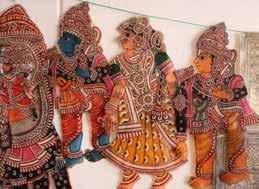





and attractive incentives, we want to position AP as an ideal co-production and shooting partner on the global stage.
Which locations in Andhra Pradesh are most frequently sought by filmmakers, and why?
How do Andhra Pradesh’s diverse landscapes—from beaches to forests—cater to varied cinematic genres?
Andhra Pradesh boasts over 300 unique and cinematic shooting locations such as Araku Valley, embedded lush green hills with rich in tribal culture, Gandikota, the “Grand Canyon of India” and the 12th Century fort village, Visakhapatnam’s beaches, Horsley Hills, dense forest areas like Maredumilli and the historic city of Amaravati are highly favoured due to their picturesque beauty and diversity. From serene coastal lines and coffee plantations to ancient temples and urban cityscapes, our state caters to all genres—from period dramas to futuristic thrillers.
Give your perspective on any undiscovered or underutilized gems in the state that could captivate international audiences?
Regions like Lambasingi (the “Kashmir of Andhra”), the mangroves of Coringa,
Belum Caves and the tribal belts of Paderu remain untapped treasures. These locations offer untouched, raw beauty and cultural uniqueness, perfect for films seeking authenticity and visual richness.
How do Andhra Pradesh’s cultural, historical sites and cinema culture in the region enhance storytelling in films?
Our state is a land of timeless legends and vibrant traditions. Historical marvels like Lepakshi, Buddhist sites like Amaravati, and rich temple architecture of Srikalahasti and Simhachalam offer depth and character to any narrative. Moreover, Andhra Pradesh’s deep-rooted film culture nurtures creativity and supports production with ease.
The film culture is embedded in the state of Andhra Pradesh and Hon’ble Chief Minister, Sh. Chandrababu Naidu has been a visionary in brining global IT and tech companies earlier in AP. Is there anything in store to boost creative economy of Andhra Pradesh
Yes, our government is investing heavily in nurturing the creative economy. We are promoting the AVGCXR (Animation, Visual Effects, Gaming, Comics, and Extended Reality) sectors, setting up dedicated media zones, and encouraging local creators through grants, mentorship, and incubation programs. This ecosystem will not only generate employment but also empower youth and make Andhra Pradesh a magnet for creative industries.
How does the government ensure a hassle-free experience for filmmakers in terms of permits and local coordination? Do you have a redressal mechanism in place for filmmakers to contact when they face problem during film shoot?
We offer a proactive Single Window Clearance System, supported by a dedicated Film Facilitation Cell. Our location-linked nodal officers assist in logistics, permits, and on-ground coordination, ensuring a seamless,
Andhra Pradesh: A Cinematic Powerhouse
• Andhra Pradesh, home to Tollywood, is a global filming destination with epic landscapes and a filmmaker-first approach.
• Films like RRR, Baahubali, and Pushpa have made waves from Cannes to the Oscars due to Andhra’s cultural fabric and scenic landscapes.
• The state boasts world-class infrastructure, including the Ramanaidu Film Studio, six airports, robust highways, and seamless rail access.
• Investment opportunities include studio development, post-production facilities, training institutes, and film tourism.
• It also offers skilled manpower on demand, with a deep-rooted legacy of Tollywood providing a ready workforce.
• Andhra Pradesh offers productionfriendly economies with competitive shooting costs, affordable accommodations, and generous government incentives.
time-bound, and filmmaker-friendly experience.
What steps has the government taken to streamline permissions for international producers and crews? Is there a single window clearance for shoot permits?
Yes, the Government of Andhra Pradesh operates a centralized digital portal for Single Window Clearance for film shoots, including for international projects, for which URL was provided in NFDC’s site.
Does the state of Andhra Pradesh have working film policy?
A comprehensive Film Policy designed to attract investments, facilitate ease of shooting, develop film infrastructure, and nurture local talent is under-way, and it will be announced shortly.
How about the availability of skilled technicians, and local crews in Andhra Pradesh?
Andhra Pradesh has a vibrant and growing pool of talented technicians, production crews, and artists. With the presence of film training institutes, strong film culture, and proximity to Hyderabad, we can efficiently cater to productions of all scales.
Are there plans to develop futuristic facilities, such as film cities or AVGC-XR hubs?
Yes, we are actively planning stateof-the-art Film Cities and AVGC-XR hubs equipped with virtual production studios, VFX labs, and post-production facilities. These projects are intended to position AP as a hub for new-age storytelling and media innovation.
What long-term legacy do you hope to create through the state’s film tourism initiatives?
By holding Tourism, Culture and Cinematography portfolios, there is an unparalleled policy synergy and administrative focus to transform Andhra Pradesh into the top destination for film shooting in India. We aspire to create a globally recognized film tourism brand that not only attracts filmmakers but also generates employment, boosts local economies, and preserves our cultural heritage through cinematic storytelling. Our goal is to build a legacy where Andhra Pradesh becomes synonymous with world-class visual storytelling.
For more details: Meet us at P-1 24.01
As the Marché du Film 2025 unfolds, it becomes clear that this is more than an industry gathering—it’s a global festival of ideas, culture, and transformation
As the cinematic world converges on the sun-drenched shores of the French Riviera in May 2025, all eyes will be on the Marché du Film, the industry-focused heart of the prestigious Festival de Cannes. Often described as the engine room of the global film industry, this sprawling marketplace is where ideas spark into life, deals are brokered, and the future of cinema is reshaped.
This year promises to be one of the most dynamic editions yet, with over 600 exhibitors from 140 countries and 15,000+ industry professionals expected to participate. As a convergence point for filmmakers, producers, sales agents, tech innovators, and visionaries, the Marché du Film is more than a marketplace—it’s the ultimate celebration of storytelling in all its evolving forms.
Since its inception, the Marché du Film has stood as a prestigious platform where creativity meets commerce. Exhibitors from every continent come together, representing a kaleidoscope of cinematic cultures. These stakeholders—ranging from national film commissions and studios to cutting-edge distributors—fuel the market’s energy, making it the key venue for forging partnerships and showcasing bold new visions.
More than 1,500 screenings are expected this year, many of them world premieres, granting attendees exclusive access to some of the most anticipated titles of the year. Whether you’re hunting for a hidden gem or finalizing international rights, Cannes is where cinema’s next chapter is often inked.
In a nod to its growing global influence, Brazil has been named the official Country of Honour for the 2025 edition. The celebration will spotlight Brazil’s vibrant and diverse audiovisual industry through showcases, curated programs, and networking events from 13 to 21 May.
This cultural spotlight coincides with the Brazil-France Season, marking 200 years of diplomatic ties. Brazilian talent will feature prominently across marquee programs such as Cannes Docs, the Producers Network, and Co-Production Day. With participation up by 50% compared to previous years, Brazil’s footprint at Cannes underscores its arrival as a major force in global cinema.
Brazilian booths hosted by Cinema do Brasil, SPCINE, and RioFilme at the Palais des Festivals will provide direct access to key players in the region’s film industry. The celebration will kick off in style as Brazil co-hosts the Marché’s Opening Night Party, with Minister of Culture Margareth Menezes welcoming attendees to a night of music, film, and festivity.

Since 2003, the Producers Network has grown into a vital program for independent producers seeking coproduction opportunities and professional connections. With over 400 global producers attending each year, this platform is where the future of storytelling is discussed over curated breakfast meetings and networking sessions.
All events are hosted at the exclusive Producers Club, a dedicated venue where new projects are born, collaborations are initiated, and the next generation of cinema leaders meet face-to-face.
For documentary professionals, Cannes Docs offers a dedicated space to explore the craft and business of nonfiction filmmaking. With its mix of panels, showcases, get-togethers, and the muchanticipated Doc Day, Cannes Docs creates meaningful interactions between directors, producers, and decision-makers.
As the appetite for documentary storytelling continues to surge globally, Cannes Docs serves as a vital platform for pushing forward bold, investigative, and artistic visions in the documentary form.
No Cannes experience would be complete without stepping into the future through Cannes Next, the innovation hub of the Marché du Film. This year’s edition is packed with high-level conferences, masterclasses, workshops, and immersive experiences focusing on AI, virtual production, immersive storytelling, and other frontier technologies.
Located at the new Village Innovation, Cannes Next is where studios meet startups, and storytelling finds its digital edge. It’s a melting pot for thought leaders, creative technologists, and producers exploring what cinema will look—and feel—like tomorrow.
Held aboard the Art Explora, the world’s largest catamaran, the Immersive Market B2B Initiative offers a bold new venue for immersive and extended reality content. Through pitching sessions, workshops, and Immersive Spotlights, professionals from the immersive industry connect with museum curators, cultural institutions, and themed venues.
This program not only accelerates collaborations but also integrates immersive storytelling into traditional film frameworks, forging global opportunities for cross-sector media development.


One of the signature elements of the Marché du Film is its robust program of over 70 expert-led conferences and panels. With change sweeping through the entertainment industry—from streaming to AI integration—the conference series aims to offer clarity, insights, and bold ideas. Expect thought-provoking discussions with global trailblazers and innovators that examine everything from the economics of filmmaking to the ethical dimensions of new storytelling platforms.
The Arab Cinema Center (ACC) returns with a four-day program (15–18 May) filled with panels, awards, and networking to showcase the region’s creative dynamism. Panels will explore key issues such as funding, co-productions, and national cinematic identities, with discussions ranging from Egypt’s rise as a blockbuster hub to financing models for independent Arab films.
The Critics Awards for Arab Films and the Arab Cinema Personality of the Year ceremony will spotlight talent and excellence from across the Arab world. With a guest list including stars like Youssra and industry stalwarts like Hussein Fahmy, the ACC continues to play a crucial role in amplifying Arab voices at Cannes.
On 16 May, financial powerhouses gather for the 15th International Film Finance Forum by Winston Baker. Taking place on the Main Stage of the Palais, this two-part program includes fireside chats on global tax incentives and production strategies, followed by an exclusive conversation with Ari Aster and Lars Knudsen on May 19.
Additional sessions like “Dreamina AI & Bladerunner Culture” will dive into emerging opportunities for sci-fi storytelling in the AI age. Representatives from leading banks, studios, and investment firms will be in attendance, making this forum a key stop for those eyeing financing trends in the global media space.
The Association of Film Commissioners International (AFCI) returns with its Global Film Commission Network Summit on 17 May, unveiling the first comprehensive Screen Tourism Playbook. Developed with SetJetters, the guide identifies best practices for turning film locations into tourism goldmines while maintaining sustainable production principles. This initiative comes as screen tourism continues to fuel travel economies, and the summit’s case studies and expert panels aim to equip destinations worldwide with tools to harness cinema’s cultural and economic pull.
Back by popular demand, the Investors Circle will unveil 10 world-exclusive projects on 18 May at Plage des Palmes. Designed for private investors, this closeddoor event introduces auteur-driven films seeking international funding. Featuring established directors like Lukas Dhont, Sebastián Lelio, and Eliza Hittman, the lineup emphasizes gender parity and European representation, with budgets ranging from €3 million to over €9 million. This invitation-only event remains a key venue for those looking to finance highend, artistic cinema with broad market potential.
The Streamers Forum returns on 18 May, gathering top players like Prime Video, Max, and newcomer Crunchyroll to dissect streaming’s evolving landscape. Topics will span production strategy, audience engagement, and cross-industry collaborations, offering a granular look into the current and future state of streaming. As streaming continues to redefine content consumption, the forum promises candid conversations with major players navigating this dynamic space.
In collaboration with the Annecy International Animation Film Festival, Animation Day will shine on 18 May
with international showcases, panel discussions, and networking events. The Annecy Animation Showcase will feature five works-in-progress, including:
• JULIÁN by Louise Bagnall
• SUNNY by Michael Arias
• ANA, EN PASSANT by Fernanda Alves Salgado
• DANTE by Linda Hambäck
Animation Day bridges the gap between commercial viability and artistic exploration, spotlighting global voices shaping the animated future.
As the Marché du Film 2025 unfolds, it becomes clear that this is more than an industry gathering—it’s a global festival of ideas, culture, and transformation. Whether you’re a seasoned producer, an emerging documentarian, or a startup pushing the limits of immersive tech, Cannes offers a platform to connect, showcase, and reimagine cinema.
With countries like Brazil and regions like the Arab world taking center stage, alongside cutting-edge tech summits and high-stakes investor forums, the Marché du Film once again cements its place as the beating heart of the film industry—and the future of storytelling.


Film Bazaar has revolutionized South Asian independent cinema since 2007, empowering filmmakers through mentorship and global connections, fostering a unique regional identity, and transforming dreams into reality
By Vineeta Mishra

Vineeta Mishra, Head of Programming, National Film Development Corporation, Film Bazaar
In the ever-evolving landscape of cinema, few platforms have had as profound and lasting an impact on South Asian independent filmmaking as the Film Bazaar. Organised by the National Film Development Corporation (NFDC) of India, Film Bazaar has grown from a modest initiative in 2007 into one of the most influential film markets in Asia, transforming not just the business of cinema but also the lives and careers of countless filmmakers.
At its core, Film Bazaar is a marketplace — but unlike traditional film markets, it was envisioned as a nurturing ground for bold voices and new narratives. It focuses on independent and regional cinema, a space often overlooked by commercial studios. By curating quality projects across languages, regions, and genres, the Bazaar offers a launchpad to projects that might otherwise struggle to find industry backing or international exposure.
The Co-Production Market, WorkIn-Progress Lab, Viewing Room, and Screenwriters’ Lab are not just sections — they are developmental accelerators. They provide mentoring, pitch training, curated meetings, and direct access to sales agents, festival programmers, funders, and distributors. These components have become vital for first-time filmmakers and even mid-career directors who are shifting toward more personal or unconventional storytelling.
Over the years, Film Bazaar has helped birth and shape films that have gone on to travel the globe, win at Cannes, Berlin, Venice, Sundance, and Toronto, and secure critical and commercial success. Notable examples
IN A COUNTRY WHERE FILM DREAMS OFTEN GETS LOST DUE TO LACK OF CONNECTIONS AND BUDGET CONSTRAINTS, FILM BAZAAR HAS BECOME MORE THAN JUST A MARKET — IT’S A MOVEMENT. IT HAS DEMOCRATIZED OPPORTUNITY, EMPOWERED FILMMAKERS WITH TOOLS AND EXPOSURE, AND FUNDAMENTALLY RESHAPED WHAT SUCCESS
include Lunchbox by Ritesh Batra, Court by Chaitanya Tamhane, Village Rockstars by Rima Das, and Liar’s Dice by Geetu Mohandas — all of which were either pitched, mentored, or shown in progress at the Bazaar.
But beyond awards and recognition, what truly underscores Film Bazaar’s importance is its role in bridging gaps. For many filmmakers, particularly those from underrepresented regions or communities, it has been their first encounter with global cinema culture. A Khasi-language filmmaker from Meghalaya or a Tamil first-timer with no big studio backing can, through the Bazaar, sit across the table from a European producer or Netflix commissioning executive.
This access is not symbolic — it is transformational. It changes how filmmakers see their own work, how they approach storytelling, and how they sustain their careers. Many come to Film Bazaar with a dream and leave with a deal, a mentor, or a global ally.
Film Bazaar has also played a critical role in strengthening the idea of a South Asian cinema identity. By inviting projects from various south Asian countries alongside Indian filmmakers, it has fostered a spirit
of regional collaboration. In an increasingly globalized world, this emphasis on cultural specificity within shared sensibilities has become one of the Bazaar’s defining strengths.
In turn, international players have come to see Film Bazaar as the gateway to authentic, powerful South Asian stories. Major global festivals, OTT platforms, and sales agents now routinely attend, not just to scout films but to engage in long-term partnerships.
As the global film ecosystem undergoes seismic shifts — with AI, streaming wars, and shrinking theatrical windows — Film Bazaar remains relevant by constantly adapting. an storytelling continues to scale new heights.
In a country where film dreams often gets lost due to lack of connections and budget constraints, Film Bazaar has become more than just a market — it’s a movement. It has democratized opportunity, empowered filmmakers with tools and exposure, and fundamentally reshaped what success can look like for Indian and South Asian cinema.
And in doing so, it has not just changed films. It has changed lives.
Under the leadership of Narayanan Ramasamy, Producer and CMD of Thenandal Studios Ltd is at Cannes Film Market to explore partnerships, collaborate, and co-produce impactful stories
In the heart of India’s vibrant film industry, Thenandal Studio Limited (TSL) stands as a beacon of creativity and resilience. As it approaches its golden jubilee in 2026, TSL is not merely celebrating five decades of cinematic excellence but is boldly charting a path toward global expansion and technologydriven storytelling.
Guided by the visionary leadership of Chairman and Managing Director Mr. Narayanan Ramasamy, TSL is at Cannes Film Market to forge partnerships, foster collaboration, and co-produce compelling stories.
Founded in 1976 by the legendary director Rama Narayanan, TSL has left an indelible mark on Indian cinema. With over 100 films produced and more than 750 films distributed across India, the studio has built a reputation for delivering stories that resonate with audiences. From timeless classics to bold new narratives, TSL’s contributions have shaped the industry’s landscape, making it one of the most prolific production houses in the country.

Narayanan Ramasamy, a steward of this rich legacy, is steering TSL into uncharted territory. “Cinema must evolve with the times,” he declares. “Our goal is to blend timeless storytelling with the limitless possibilities of technology.” This ethos is driving
TSL’s ambitious plans for international expansion, strategic partnerships, and innovative filmmaking techniques.
TSL is embracing the future with open arms, exploring AI-based filmmaking, blockchain integration, and content tokenisation. These advancements aim to enhance viewer experiences, streamline production, and unlock new avenues for creative expression. By marrying tradition with technology, TSL is positioning itself at the forefront of the next generation of cinema.
TSL’s recent release, “Mr. Housekeeping” (January 2025), has captured hearts with its quirky charm and emotional depth, earning both critical acclaim and box-office success. The studio is now in post-production for “Iravaakaalam”, a gripping thriller starring S. J. Suryah, Waqima Gabbi, and Sshivada, set to further solidify TSL’s reputation for bold storytelling.
Looking ahead, TSL’s slate is brimming with promise:
“Sanghamitra”: A grand historical saga in pre-production, poised to dazzle audiences with its visual splendor.
“Aadi Velli”: A reimagining of the 1990 blockbuster, this reboot will leverage AI tools, a fresh cast, and modern storytelling to captivate today’s viewers.
TSL’s ambitions extend far beyond India’s borders. In 2025, the studio will make a significant mark at the Cannes Film Festival, engaging with global filmmakers at the Marché du Film. By forging international collaborations and co-production opportunities, TSL aims to bring Indian stories to a worldwide audience, amplifying the cultural richness of its narratives.
As TSL approaches its 50th anniversary, it stands at the cusp of a transformative era. With a legacy rooted in storytelling and a future driven by innovation, the studio is redefining Indian cinema’s role on the global stage. Narayanan Ramasamy’s vision—connecting tradition with technology, local with global—ensures that TSL will remain a creative force for decades to come.
Thenandal Studio Limited is not just celebrating a milestone; it’s crafting a legacy for the future—one frame at a time.

Recognized globally for his lyrical, meditative style and profound humanism, Shaji N. Karun’s contribution to cinema—both as a director and as a pioneering cinematographer—helped shape the trajectory of Indian art cinema on the international stage
By Pierre Assouline
It was in Cannes, 1994, amidst the orchestrated frenzy of the Competition, that I first met Shaji N. Karun. He was there with Swaham, I with a story — Vanaprastham — in search of the right filmmaker. In Shaji, I met a man untouched by the vanity and disorientation that Cannes so often bestows upon its chosen. He carried no infatuation for glamour, no hunger for acclaim.

with immediate instinct, transposed the tale to Kerala — to Kathakali. It was not a negotiation; it was a revelation. I knew then I had met a director of rare understanding — one who knew a story must be made one’s own to truly live. We both agreed: the films that travel furthest are those rooted firmly in their own soil, never pandering to foreign eyes.
We spoke of Vanaprastham. My initial vision was set in Orissa, with an Odissi master at its heart. But Shaji,

That serendipitous meeting grew into a lasting collaboration and a deep friendship — from the production of Vanaprastham, its French and


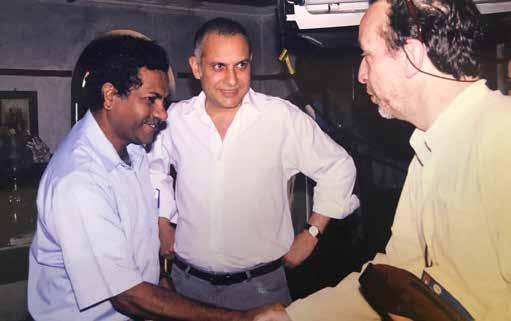
“He carried no infatuation for glamour, no hunger for acclaim.”
international release, to the European journeys of Piravi, Swaham, and later, the haunting fable Olu, which I had the privilege of shepherding as Creative Producer. Over those years, through countless exchanges, I came to know a filmmaker and a man who remained unflinchingly true to himself from the first day we met.
Shaji, the Man
Shaji spoke in a soft, whispering voice — English laced with unusual rhythms and surprising pairings, often forming what we playfully called “Shaji-isms.” His language was visual, elliptical, sometimes enigmatic. Many were baffled by his ethereal phrases, but over time I grew attuned to their sophisticated expression. He was an artist in the truest sense — a visual poet, a tender humanist. He bore little regard for Bollywood’s noise, its
“He was an artist in the truest sense — a visual poet, a tender humanist.”
creative poverty, its commodification of cinema. Yet he wasted no breath in criticism. He preferred to speak of masters he admired, or ideas for new films that lit up his inner world.
Loyal to those he worked with, he treated everyone with care — from stars to the last technician. He had a distaste for undue hierarchy. Whether on set or traveling, he chose simplicity: modest hotels, unpretentious meals. Affection touched him deeply. So did betrayal. He was wounded when a cherished project on Raja Ravi Varma, meant to be his great tribute to the painter, was left adrift by a trusted producer. Years later, he forgave him. Another heartbreak came when Reliance failed to properly release Kutti Srank, his film starring Mammootty.
Shaji and Cannes Shaji’s bond with Cannes was singular.
“India’s Shaji Karun is of the vein of the great Satyajit Ray.” — Gilles Jacob
“Whether on set or traveling, he chose simplicity: modest hotels, unpretentious meals.”
“Affection touched him deeply. So did betrayal.”
The legendary Gilles Jacob, the last festival head to truly understand Indian cinema, selected Piravi, Swaham, and Vanaprastham. He once said, “India’s Shaji Karun is of the vein of the great Satyajit Ray.” For Shaji, no accolade meant more than this quiet recognition. When Olu narrowly missed selection in 2018, the grief was quiet but deep.
I remember screening Piravi after discovering Swaham. Selected in 1989 in Un Certain Regard, it received the Caméra d’Or Special Mention. It was a minimalist elegy, based on a true story from India’s Emergency — a father’s long wait for a son who never returns. Shaji told it with silences, stillness, and heartbreaking restraint. I released it in France, where its quiet power left audiences moved.
Swaham, selected for Competition in 1994, was scheduled as the final screening — a slot notoriously unfavorable for awards, when jury decisions are mostly already made. Yet Shaji’s camera elevated the quiet ordeal of a widow into a universal lament. I released it in France as Destinée. The response was generous — both critical and public — and built anticipation for Vanaprastham.
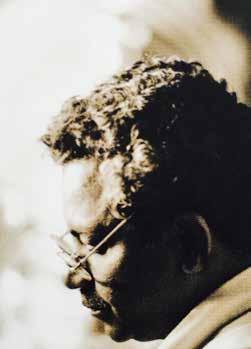
“He bore little regard for Bollywood’s noise, its creative poverty, its commodification of cinema.”
“He wasted no breath in criticism. He preferred to speak of masters he admired.”
By 1999, with CLT-UFA onboard as international sales agent and SND as French distributor, Vanaprastham enjoyed rare visibility on the Croisette. Posters lined the promenade, and the market hosted a dedicated booth. The starry team — Mohanlal, Suhasini, Suresh Balaje, Zakir Hussain — arrived in strength in Cannes. The screening was luminous, followed by what the press called “the finest party of the festival”: a villa lit with laughter, Indian vegetarian delicacies, and a transcendent private concert by Zakir and John McLaughlin. Though the film had missed Competition, Shaji was quietly consoled by the celebration of his work.

“Shaji’s bond with Cannes was singular.”
“The artist in him never stopped yearning.”
Variety, in its Cannes review, saw the film clearly: “A poignant commentary on the political and mythic role of artists in a rapidly changing society, which marks noted Indian cinematographerdirector Shaji Karun’s third appearance in Cannes. Vanaprastham is an elaborately produced, exceedingly handsome period film which affirms Karun’s stature as one of India’s premier filmmakers.” Shaji, the auteur, was crowned.
Shaji, the Yearning Artist
In later years, as Chairman of the Kerala State Film Development Corporation, Shaji gave himself fully to shaping policy and nurturing cinema in his home state. But the artist in him never stopped yearning. In one of our last exchanges, he wrote to me: “I wish that I should relinquish my KSFDC responsibility and fully engage in my
creativity. Finally, my film Gaadha is still haunting me!” The Gaadha project, based on T. Padmanabhan’s short story Kadal, had faced its share of setbacks. But it was quintessential Shaji — a meditation on solitude, longing, and the sea as metaphor for the unknowable heart of human relationships.
Our final correspondence was one of shared grief — over the passing of Zakir Hussain last December. Shaji wrote to me, “It is always an honour for all of us the master has given us the best.”
And now, dear Shaji, it is our turn to echo your words — in gratitude: “It is always an honour for all of us — the master has given us the best.”
To the Chevalier de l’Ordre des Arts et des Lettres of the French Republic, I say in farewell: Salut, le Poète! Salut, l’Artiste!
A producer in France and India with Selections and Awards including Competition in Venice, Competition and Jury Award in Locarno, Competition in Toronto, Official Selection in Cannes, National Award in India, Pierre Assouline currently works at establishing “The Uplifting Cinema Project”, a production slate of universal and uplifting films conveying India’s beauty to the world.
Pierre Assouline in Cannes WhatsApp +33613215900 pierre@theupliftingcinemaproject.com



AFFEKSJONSVERDI (SENTIMENTAL VALUE)
Sisters Nora and Agnes reunite with their estranged father, the charismatic Gustav, a once-renowned director who offers stage actress Nora a role in what he hopes will be his comeback film. When Nora turns it down, she soon discovers he has given her part to an eager young Hollywood star. Suddenly, the two sisters must navigate their complicated relationship with their father — and deal with an American star dropped right into the middle of their complex family dynamics.
Directed by : Joachim TRIER
Year of production: 2025
Country: Norway, France, Denmark, Germany
Duration: 135
Alpha, a troubled 13-year-old lives with her single mom. Their world collapses the day she returns from school with a tattoo on her arm.
Directed by : Julia DUCOURNAU
Year of production: 2025
Country: France, Belgium
Duration: 128


DIE MY LOVE
Directed by : Lynne RAMSAY
Year of production: 2024
Country: Canada
Duration: 118

DOSSIER 137 (CASE 137)
What begins as a minor accident sets in motion a series of escalating consequences.
Stéphanie, a police officer working for Internal Affairs, is assigned to a case involving a young man severely wounded during a tense and chaotic demonstration in Paris. While she finds no evidence of illegitimate police violence, the case takes a personal turn when she discovers the victim is from her hometown.
Directed by : Dominik MOLL
Year of production: 2025
Country: France
Duration: 115
Directed by : Jafar PANAHI
Year of production: 2025
Country: Iran, France, Luxembourg
Duration: 105

JEUNES MÈRES

Jessica, Perla, Julie, Ariane and Naïma are housed in a shelter for young mothers. Five teenagers hoping for a better life for themselves and their babies.
Directed by : Jean-Pierre DARDENNE, Luc DARDENNE
Year of production: 2025
Country: Belgium, France
Duration: 104

The story of a family and a family business.
Directed by : Wes ANDERSON
Year of production: 2024
Country: Germany
Duration: 105
This is the story of Godard making “Breathless”, told in the style and spirit in which Godard made “Breathless”.
Directed by : Richard LINKLATER
Year of production: 2025
Country: France
Duration: 105


Marina, 18, orphaned at a young age, must travel to Spain’s Atlantic coast to obtain a signature for a scholarship application from the paternal grandparents she has never met. She navigates a sea of new aunts, uncles, and cousins, uncertain whether she will be embraced or met with resistance. Stirring long-buried emotions, reviving tenderness, and uncovering unspoken wounds tied to the past, Marina pieces together the fragmented and often contradictory memories of the parents she barely remembers.
Directed by : Carla SIMON
Year of production: 2025
Country: Spain, Germany
Duration: 115

In a sedate corner of Massachusetts circa 1970, JB Mooney (Josh O’Connor) an unemployed carpenter turned amateur art thief, plans his first big heist. When things go haywire, his life unravels.
Directed by : Kelly REICHARDT
Year of production: 2025
Country: United States Duration: 110
When a titan music mogul (Denzel Washington), widely known as having the “best ears in the business”, is targeted with a ransom plot, he is jammed up in a life-or-death moral dilemma. Brothers Denzel Washington and Spike Lee reunite for the 5th in their long working relationship for a reinterpretation of the great filmmaker Akira Kurosawa’s crime thriller High and Low, now played out on the mean streets of modern day New York City.
Directed by : Spike LEE
Year of production: 2024
Country: United States Duration: 133

VIE PRIVÉE (A PRIVATE LIFE )

When renowned psychiatrist Lilian Steiner learns of the death of one of her patients she is deeply troubled. Convinced that it was murder, she decides to investigate…
Directed by : Rebecca ZLOTOWSKI
Year of production: 2025
Country: France Duration: 105

11-12 October 2025
Cannes, France
13-16 October 2025
Cannes, France
18-21 November 2025
Cancun, Mexico
February 2026
London, United Kingdom

In Eleanor The Great, June Squibb brings to vivid life the witty and proudly troublesome 94-year-old Eleanor Morgenstein, who after a devastating loss, tells a tale that takes on a dangerous life of its own. Scarlett Johansson’s directorial debut is a comically poignant exploration of how the stories we hear become the stories we tell.
Directed by : Scarlett JOHANSSON
Year of production: 2024
Country: United States
Duration: 98LEANOR THE GREAT
Two childhood friends from a small North Indian village chase a police job that promises them the dignity they’ve long been denied. But as they inch closer to their dream, mounting desperation threatens the bond that holds them together.
Directed by : Neeraj GHAYWAN
Year of production: 2024
Country: India
Duration: 119

LOVE ME TENDER

One late summer, Clémence tells her ex-husband that she’s having romantic relationships with women. Her life is turned upside down when he takes custody of her son. Clémence must fight to remain a mother, a woman and a free woman.
Directed by : Anna CAZENAVE CAMBET
Year of production: 2025
Country: France
Duration: 134

A semi-autobiographical tale set over the course of a single day in the Nigerian capital Lagos during the 1993 Nigerian election crisis. The story follows a father, estranged from his two young sons, as they travel through the massive city while political unrest threatens their journey home.
Directed by : Akinola DAVIES
Year of production: 2025
Marie, an Ivorian pastor and former journalist, has lived in Tunisia for ten years. Her home becomes a refuge for Naney, a young mother seeking a better future, and Jolie, a strong-willed student carrying her family’s hopes. The arrival of a little orphan girl challenges their sense of solidarity in a tense social climate, revealing both their fragility and strength. MY FATHER’S SHADOW UNCERTAIN
Directed by : Erige SEHIRI
Year of production: 2025
Country: France, Tunisia, Qatar
Duration: 92

THE CHRONOLOGY OF WATER
Country: United Kingdom, Nigeria
Duration: 94

Brought up in an environment torn apart by violence and alcohol, Lidia Yuknavitch seemed destined for self-destruction and failure until words offered her unexpected freedom in the form of literature. The Chronology of Water, adapted from Yuknavitch’s autobiographical bestseller, follows Lidia’s journey to find her own voice in an exploration of how trauma can be transformed into art through re-possessing our own bloody histories, particularly those uniquely experienced by the bodies of women and girls.
Directed by : Kristen STEWART
Year of production: 2025
Country: France, Latvia, United States
Duration: 90

UNCERTAIN REGARD
In 1982, UK. An aspiring Japanese-British writer plans to write a book based on her mother Etsuko’s post-war experiences in Nagasaki. Etsuko, haunted by the suicide of her older daughter, begins to recount her memories from 1952 as a young mother-to-be. Her story begins with her encounter with Sachiko, who was full of hope about starting a new life abroad, and her young daughter Mariko, who constantly spoke of an eerie woman. The writer finds something at odds as she confronts the mementoes of her mother’s Nagasaki years, as well as the memories Etsuko shares with her.
Directed by : Kei ISHIKAWA
Year of production: 2025
Country: Japan, United Kingdom, Poland
Duration: 123
Magellan is a navigator rebelling against the power of the King, due to his humanism and belief in justice. But once he is finally in command of the Spice Fleet, in which he will make the first circumnavigation of the Earth, what will his journey unravel about himself?
Directed by : Lav DIAZ
Year of production: 2025
Country: Portugal
Duration: 156


Amrum Island, Spring 1945. In the final days of the war, 12-year-old Nanning braves the treacherous sea to hunt seals, goes fishing at night, and works the nearby farm to help his mother feed the family. Despite the hardship, life on the beautiful, windswept island almost feels like paradise. But when peace finally comes, it reveals a deeper threat: the enemy is far closer than he imagined.
Directed by : Fatih AKIN
Year of production: 2025
Country: Germany
Duration: 93


























Pickle reaches out to audio visual companies in over 50 countries; Targets global buyers and distributors; Film Festivals and markets; Animation production companies; Global companies looking at offshoring from India; Co-production seekers and location service providers. Pickle business guide tracks the entertainment business in India.
Congratulations to Annecy Festival and its team for being a torch-bearer of animation industry for over six decades
Email : pickle@pickle.co.in Web: www.pickle.co.in












8-14


